You Can Go Home Again Toledo Magazine
Editor's Note, September vi, 2019: Francisco Toledo, the titanic expressionist creative person, mourned by Mexico and the world, has died at age 79 in his native Oaxaca. Before this year, writer Paul Theroux gained unprecedented access to Toledo for Smithsonian'due south exclusive, in-depth profile of the artist-activist.
When Francisco Toledo heard that a McDonald's was to open up in the elegant, nearly 500-year-old Zócalo, or town square, the heart of Oaxaca City, he devised an ingenious method of protest: He appear that he would take off all his clothes and stand naked in front of the site of the proposed Golden Arches. And to remind Mexicans of the pleasures of their ain food he would enlist the aid of some young man artists and manus out free tamales to anyone who joined the protest.
"We resisted with him," the Oaxacan painter Guillermo Olguín told me. "Nosotros showed that civil society has a voice. We bought banana leaves. I made some posters. We were the soldiers to represent the people. We gear up upward tables. Information technology was a happening!"
Hundreds of people marched in the 2002 outcome, raised their fists and chanted, "Tamales, yes! Hamburgers, no!" In the stop, in that location was such a public outcry that Toledo did not find it necessary to have off his clothes—the tamales did the trick.
In 2014, Toledo protested again, over a far more than serious affair, the disappearance of 43 students in Ayotzinapa, in the land of Guerrero, presumably murdered by the local police, with the connivance of drug cartels. When it seemed that no one in the government cared very much (and indeed might have been involved), Toledo painted portraits of the students on 43 kites, and encouraged people in Oaxaca to wing these works of art every bit protests. And and so "Ayotzinapa Kites" was another happening that raised awareness equally it memorialized the victims.
"He's a behemothic," Olguín said. "All the people in Mexico involved in the creative procedure should be grateful to him."
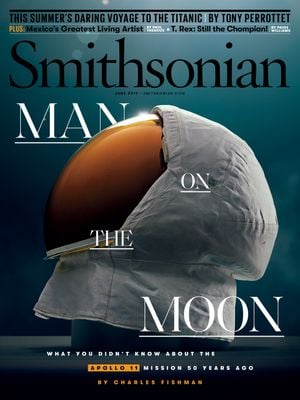
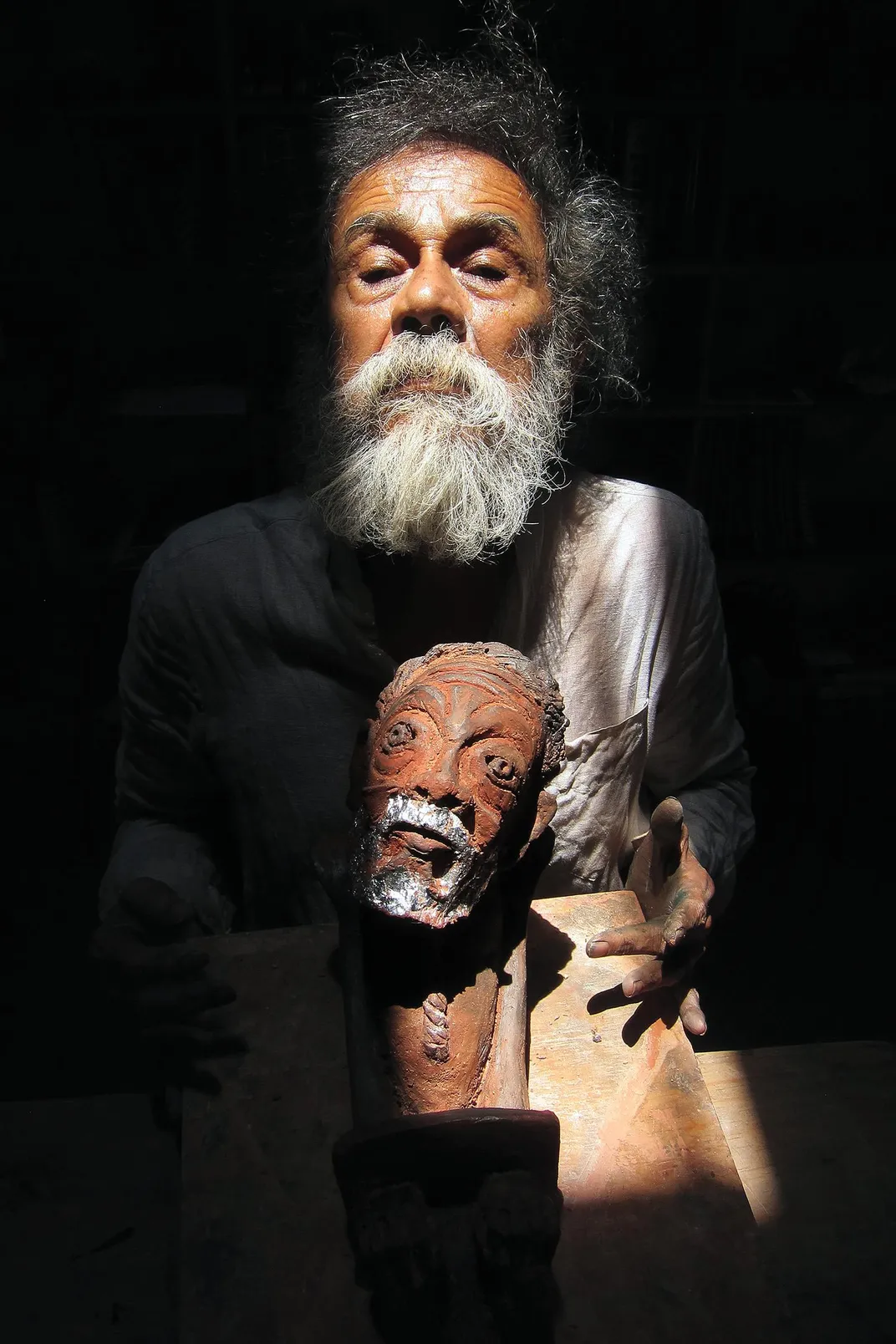
An creative person, an activist, an organizer, the embodiment of Oaxaca's vortex of energy, and a motivator, Toledo is known as El Maestro. That is an appropriate description: the principal, also teacher and say-so figure. His piece of work, and the results of his campaigns and his philanthropy, can be seen everywhere; but the man himself is elusive. He hides from journalists, he hates to be photographed, he seldom gives interviews, he no longer attends his own openings, just instead sends his wife and daughter to preside over them, while he stays in his studio, unwilling to speak—a great example of how writers and artists should respond—letting his piece of work speak for him, with greater eloquence.
It is said that Toledo courts anonymity, not celebrity. He is that maddening public figure, the person and then determined to avert beingness noticed and to maintain his privacy, that he becomes the object of exaggerated scrutiny, his privacy constantly under threat. Information technology is the attention seeker and the publicity hound who is consigned to obscurity—or ignored or dismissed. The recluse, the shunner of fame, the "I just want to be alone" escapee—Garbo, J.D. Salinger, Banksy—seems perversely to invite intrusion. Say "Absolutely no interviews," and people shell a path to your door.
Fascinated by his work and his activism, I was provoked to become one of those intruders. Incurable nosiness is the true traveler'south essential but least likable trait. I put in a request to encounter Toledo, through his girl, Sara, and looked farther into Toledo's public life.
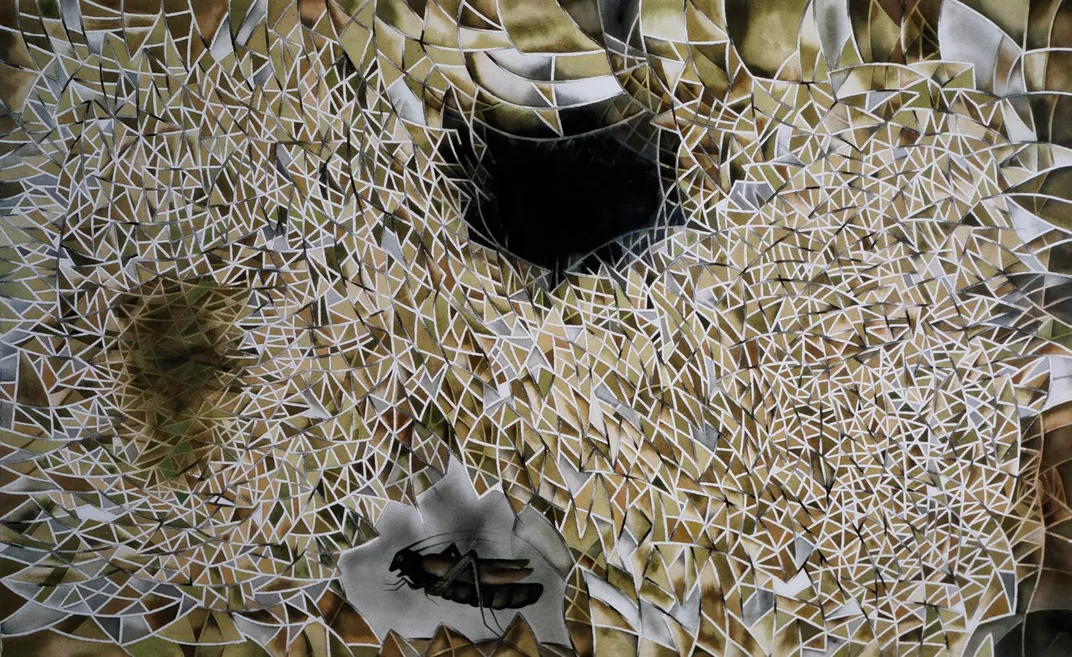
He remains a fully engaged artist, expanding a protean output—at that place are around nine,000 documented works—that defines a titan spanning 20th- and 21st-century fine art. "Toledo has no limitations," says William Sheehy, director of the Latin American Masters gallery in Los Angeles, who first encountered the artist's piece of work forty years ago. The real comparison, he adds, is "with Picasso."
Mingling influences from Goya to Klee with his roots in the fabulism and folk traditions of Oaxaca, Toledo's piece of work bears the stamp of a galvanic life force. "He has transposed his observations into a linguistic communication of his own," says Sheehy, "fusing the human and natural worlds of his childhood—it's all about connectivity."
Yet he has non ceased to protest—these days the abuses of trade agreements, especially the prospect of U.S. companies introducing genetically modified corn into Mexico and thus undermining the integrity of age-old strains of native corn. One of his protestation posters shows Mexico's revered 19th-century reformer, Benito Juárez, sleeping on eight or x ears of corn and above him "Despierta Benito!" ("Wake Upwards Benito!") and "Y di no al maíz transgénico!" ("And reject genetically modified maize!").
These preoccupations give some indication of Toledo'south passion. From the age of nine, when he was singled out in his school for his exceptional drawing ability (the picture happened to be a portrait of Juárez), Toledo has worked almost without a interruption, that is, 70 years—he turns 79 this July. He works in every conceivable medium—oil, watercolor, ink, metal; he makes cloth puppets, lithographs, tapestries, ceramics, mosaics and much more than. He may produce a canvas depicting a vintage sewing motorcar, fragmented into Cubist-inspired components; create a ceramic of a mysterious bovine morphing into a kind of Minotaur; or paint a rushing river glistening with gold leaf and roiling with skulls.
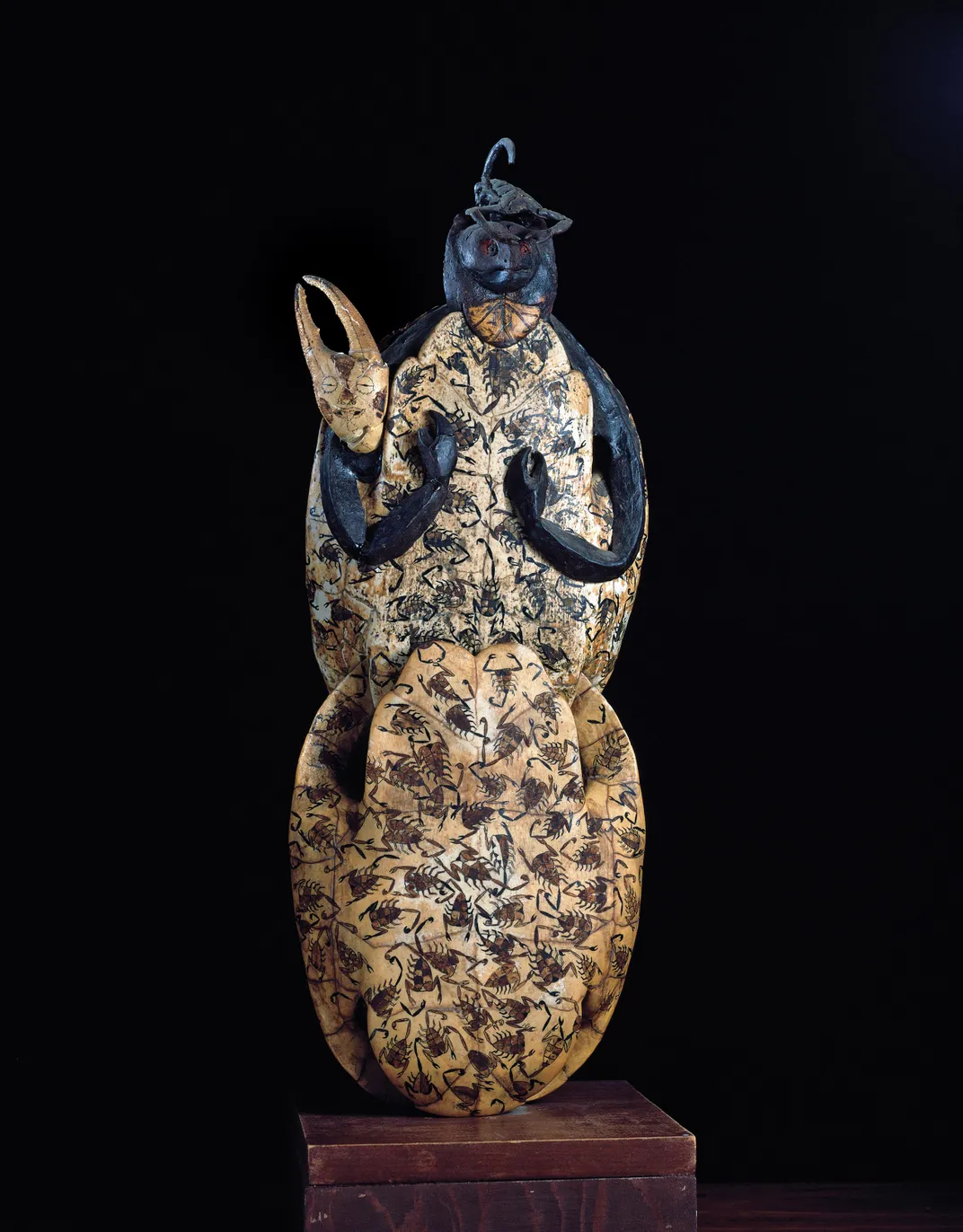
Though his paintings and sculptures sell all over the globe for fabulous prices, he has non enriched himself. He lives simply, with his married woman, Trine Ellitsgaard Lopez, an achieved weaver, in a traditional house in the middle of Oaxaca, and has used his considerable profits to establish art centers and museums, an ethnobotanical garden and at least three libraries.
IAGO is one of a number of cultural institutions that Toledo had founded—the Instituto de Artes Gráficas, a graphic arts museum and library housed in a colonial edifice across from Oaxaca'due south famed Santo Domingo Church building, dating back to 1571. A gimmicky fine art museum, MACO, is another, forth with a photographic annal (Toledo is also a distinguished lensman), a rare book library, a store that made handmade paper for his prints, an environmental and cultural protection nonprofit organization. 1 library devoted solely for the utilise of the blind, with books in Braille, is named Biblioteca Borges, after the blind Argentine writer.
Most of these institutions charge no admission. Toledo believes that anyone who wishes should be allowed to enter these places and enlighten themselves, free. A country boy himself, he hopes that people from small villages, who might exist intimidated by museums and forbidding public institutions, will visit and look at fine art produced locally.
* * *
Sara promised to aid arrange the coming together. She was alpine, half-Danish, preparing me for the visit, explaining that her father had non been well. She said that it was in my favor that her father knew that xviii of my books, both in Spanish and English, were on the shelves of IAGO.
Another reason for my seeing Toledo was that he was less than a year older than I. As the years have passed I have nurtured a special feeling for anyone close to my historic period. It means that we grew up in the same world, in the austere aftermath of World War 2, that we knew the same terrors and tyrants and heroes, likewise as the same cultural touchstones, sure books, sure fashions, items of slang, the music of the '50s. We were in our early 20s in the tumble and conflict of the '60s, witnessed the civil rights struggle, nuclear testing, Vietnam, the women's movement and, distrustful of the received wisdom of the by, we discovered new ways of looking at ourselves and the globe. Nosotros were hopeful, seeing oppressive institutions shaken up, and decolonization in Africa. We had lived through an era when authorisation was challenged past some activists like us, from the margins of society.
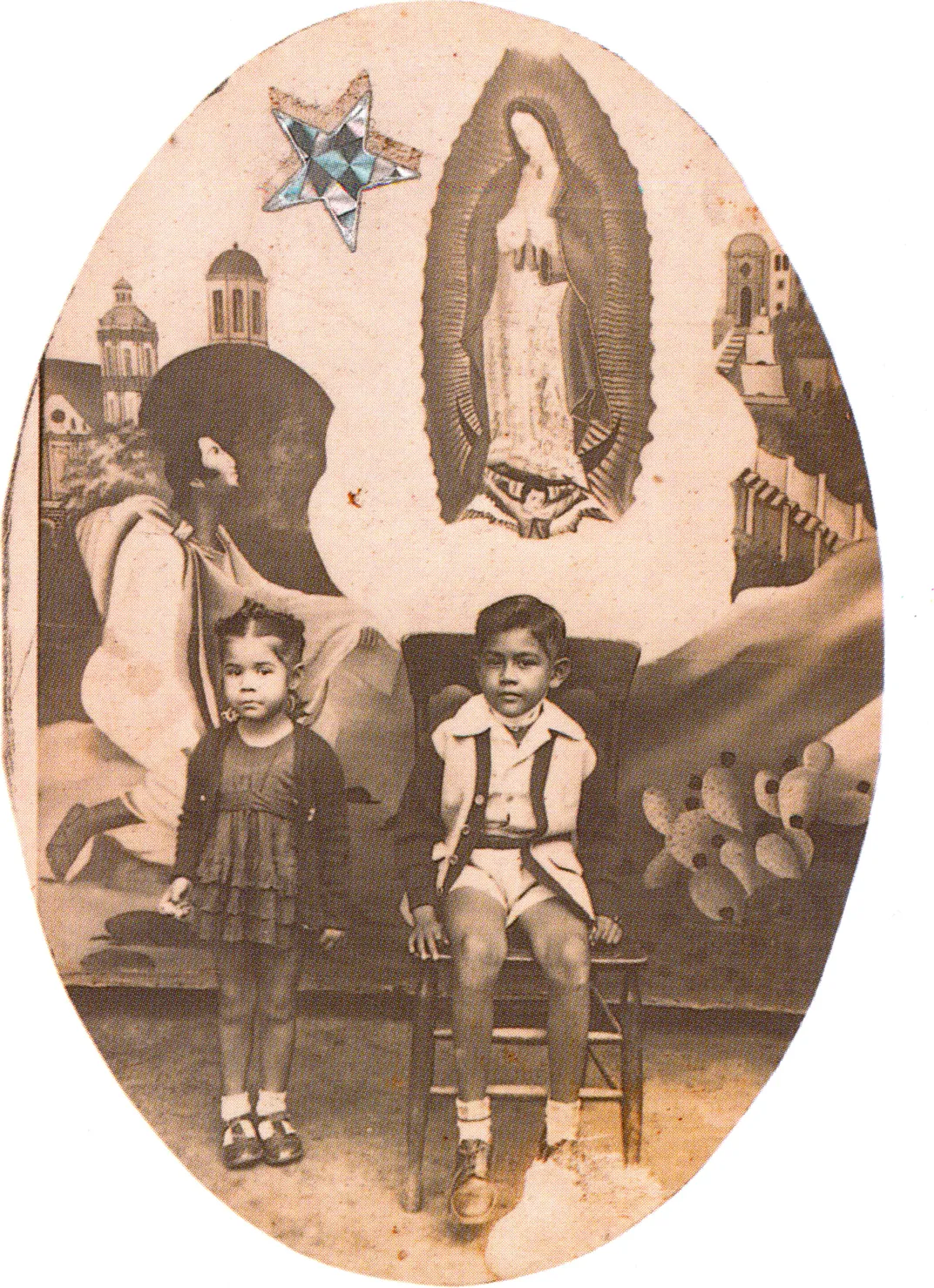
Toledo, whose origins were obscure and inauspicious, was the son of a leatherworker—shoemaker and tanner. He was born in Mexico Urban center, but the family unit soon afterward moved to their ancestral village near Juchitán de Zaragoza in the Isthmus of Tehuantepec, nearer to Republic of guatemala than to Mexico Urban center—and existence ethnically Zapotec, nearer culturally to the ancient pieties of the hinterland besides. Though widely traveled ("Really we grew up in exile"), he claims Juchitán as his home, saying, "You're from where yous feel you're from." The Toledo family kept moving, finally settling in Minatitlán near Veracruz, where his father set himself up as a shopkeeper.
Toledo was a dreamy child, much influenced by Zapotec myths and legends, and the wildlife and flora of a rural upbringing—elements that emerged in his art to the extent that he has become ane of the greatest interpreters of Mexican mythologies. His piece of work is filled with the many Zapotec deities, the bat god, the gods of rain and fire, and the sacred animals—rabbits, coyotes, jaguars, deer and turtles that make much of his piece of work a magical bestiary.
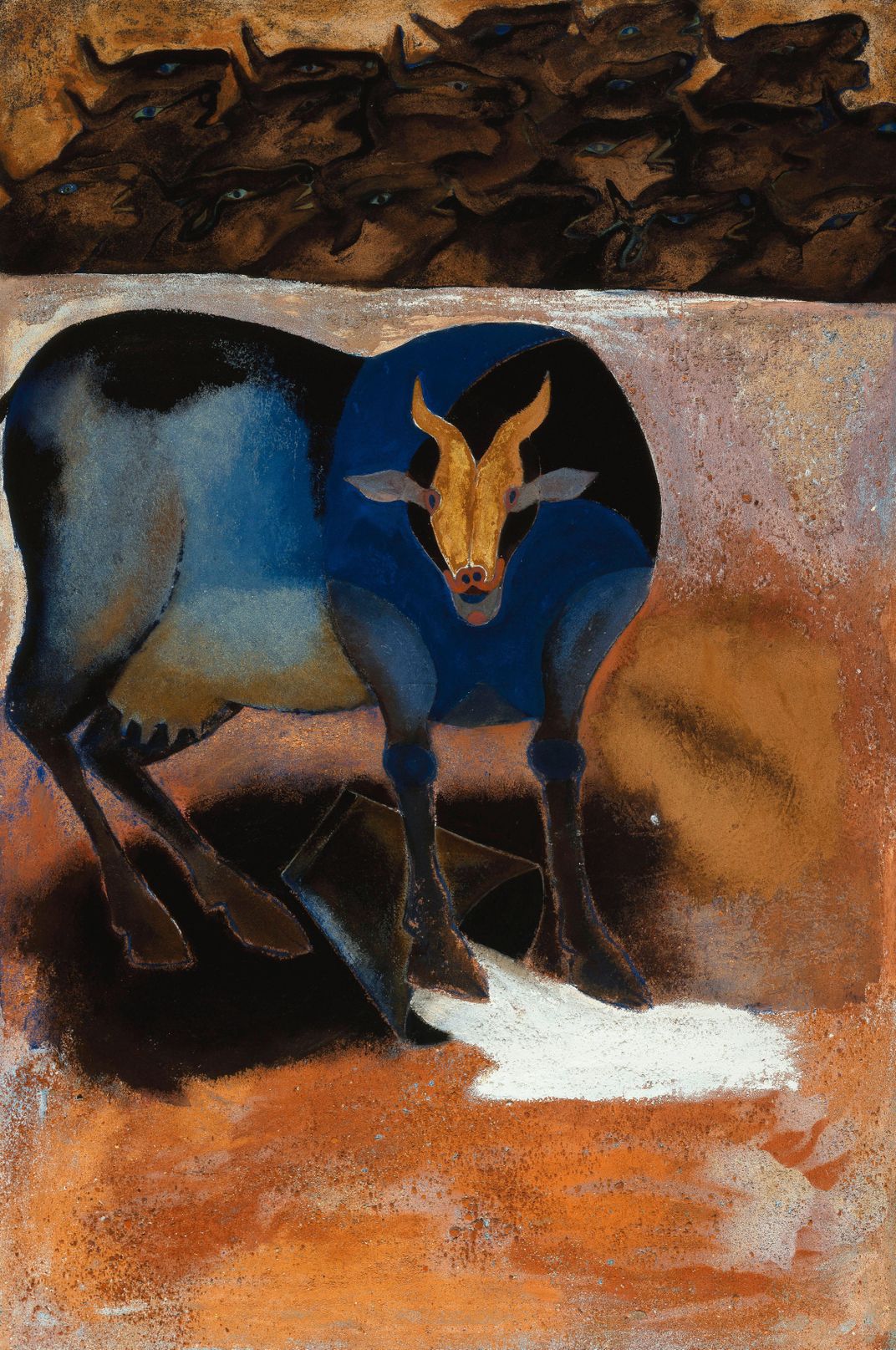
Recognizing immature Francisco'due south talent, his parents sent him to Mexico City to written report the techniques of graphic fine art at the Instituto Nacional de Bellas Artes. He was merely 17, but withal he was singled out by critics and connoisseurs for his luminescence and held his get-go solo exhibitions two years later, in Mexico City and in Fort Worth, Texas. Restless and now solvent, ambitious to know more, only nevertheless young—barely 20—he went to Paris, to continue painting, sculpting and printmaking.
In Paris he was mentored past some other Mexican departer, and fellow Zapotec, Rufino Tamayo, and after worked in the atelier of the English expatriate printmaker Stanley Hayter, learning copper engraving. Later on Toledo's first Paris evidence in 1963, the influential French novelist and art critic André Pieyre de Mandiargues wrote, "The great and very pleasant surprise that nosotros had in our commencement encounter with this Zapotec Indian was that of finally discovering a sort of genius in the arts, comparable in some ways to 'the divine facility' of certain masters...."* And he went on, "I know of no other modern artist who is then naturally penetrated with a sacred conception of the universe and a sacred sense of life." This was a vital endorsement, because Mexican writers and painters seldom gain recognition at dwelling until they've been praised abroad.
Nostalgic less for the big world of Mexico than his remote bequeathed pueblo, Toledo abandoned Europe and returned home in 1965—first a spell in Juchitán determined to promote and protect the arts and crafts in his native state of Oaxaca (he designed tapestries with the village craftsmen of Teotitlán del Valle), so moving to Oaxaca Urban center, where he helped create a cultural awakening, with his indignation and his fine art. Though he returned to Paris after for a period, and lived and worked in the 1980s in New York Urban center and elsewhere, Oaxaca remains his home.
"He works all the time," Sara told me. "He's however painting. He's multitasking. He makes fences of iron—well, they expect similar fences. They're sculptures. He works with all sorts of textile—felt, carpets, tiles, ceramics, glass, light amplification by stimulated emission of radiation cutouts. He makes toys, he makes felt hats for little kids."
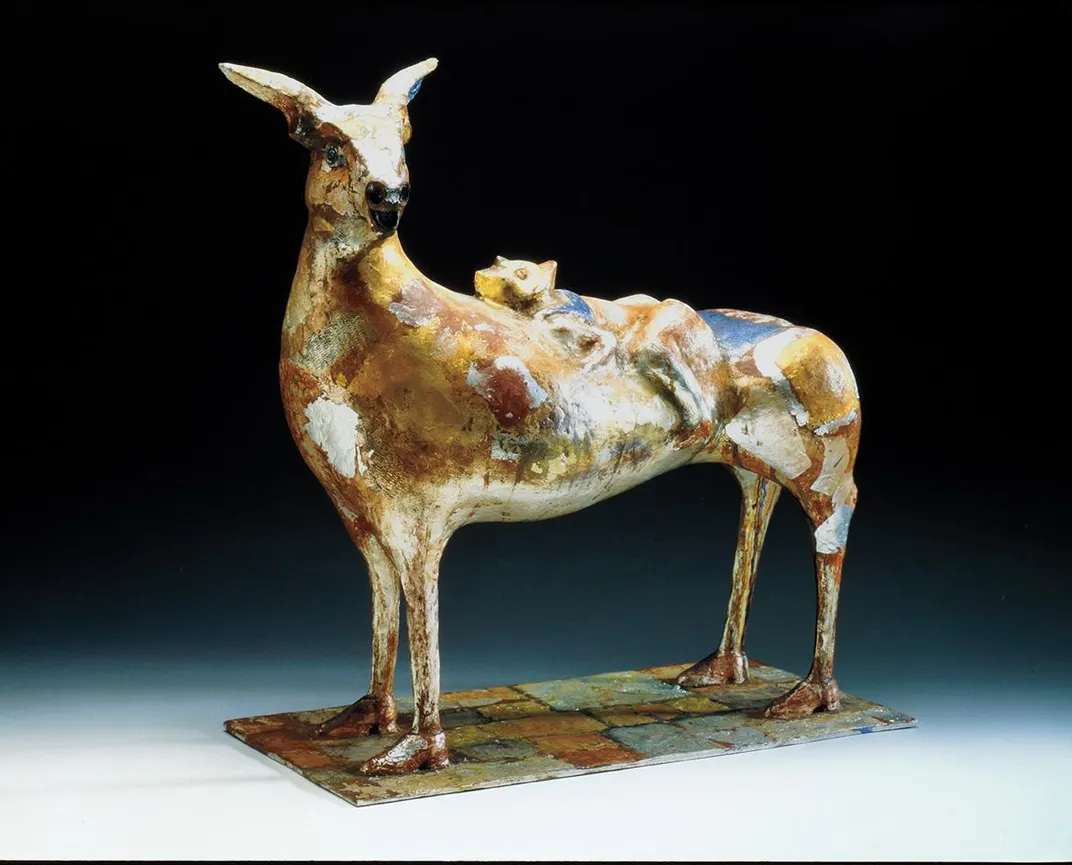
The earthquake that had destroyed parts of United mexican states City in September 2017 also laid waste to an enormous department of the metropolis of Juchitán, and moved him to action again.
"We formed a group called Amigos del IAGO and fix 45 soup kitchens in and around the city of Juchitán, and in other parts of the isthmus," Sara said. "We were feeding v,000 people a day for four months, until people got back on their feet."
And she explained that the soup kitchens were non an entirely exterior effort—a charity, doing everything—but rather a cooperative system, more often than not operated by the Juchitán people themselves, with finance from Toledo. "Having something to do was therapeutic for them," Sara said. "It took their mind off the earthquake."
Not long afterward this conversation with her, she gave me the discussion: I could meet Toledo at the arts center, where a show of his work was being mounted.
* * *
I arrived early enough to have a brisk walk-through of the new show and was dazzled by the multifariousness of works—fe sculptures hung apartment against the wall like trellises of metal grid, posters with denunciations in large letters, hand puppets, hats, lithographs of mottoes, dolls in Zapotec dresses, a felt corncob labeled Monsanto, with a skull on it, and serene ink drawings—a large one completely covered with a shoal of beautifully rendered darting shrimp, flashing to one border of the paper.
"Hola!" I heard, and looked upwardly from the drawing of the darting shrimp and saw Toledo walking toward me.
The kickoff thing, the nigh obvious aspect of the man, was his head—a large, imposing head, familiar to anyone who knows his piece of work, because Toledo has painted hundreds of self-portraits. With an intense gaze, accentuated by a tangled nest of wild hair, the head is much likewise big for his slender body, the slight body, sparse artillery, skinny legs, looking doll-similar and improbable. He seemed cautious and subdued, but courtly, austerely polite in the manner of quondam-fashioned Mexicans. I besides felt at once, seeing his crooked smile, and the way he bounced when he walked, that he had besides much heart and humor to brand himself unapproachable. Some people—Toledo is one—are so naturally generous they have a justifiable fear of the clutches of strangers.
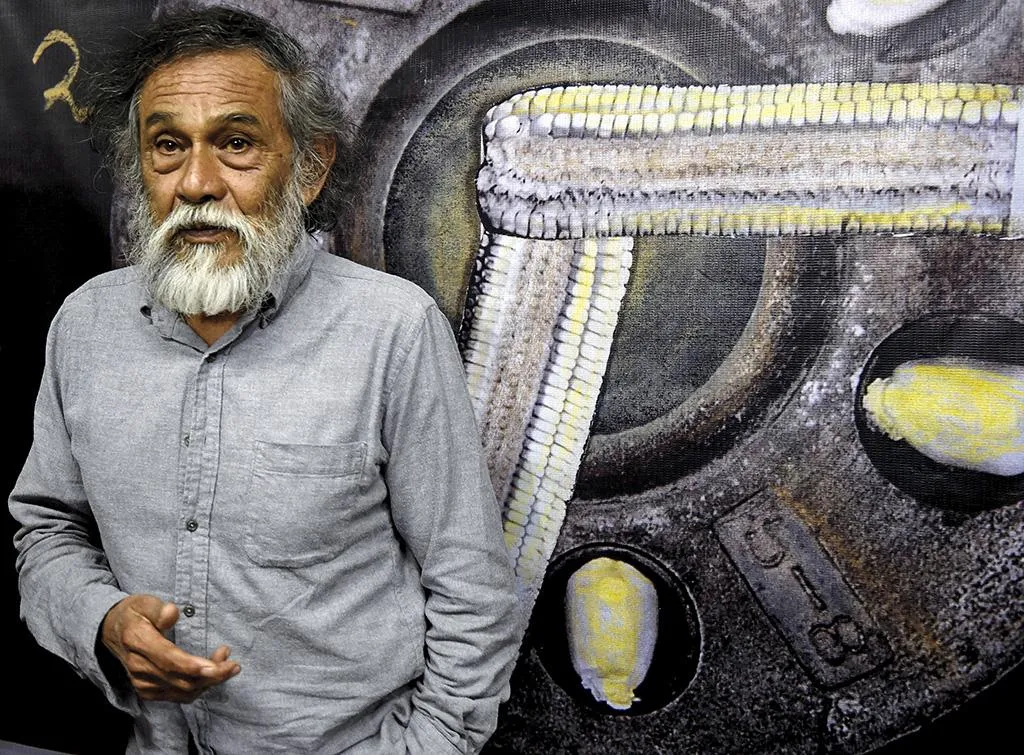
"This is lovely," I said, of the drawing.
"Camarones," he said, and tapped the glass of the case it lay in, shimmering with life and movement. "I similar the style they swim together. You see the pattern?" And equally though this explained everything, he added, "Juchitán is near the ocean."
He signaled to his daughter and made a sign with his fingers that indicated java drinking.
He became blithe, grinning, every bit nosotros walked around the exhibition. At the "Despierta Benito!" protest affiche, he said, "This is confronting the government."
A lithograph under glass was a copy of a 17th-century Spanish manuscript list a Zapotec vocabulary, for the utilise of missionaries and officials. Some other was also based on an erstwhile certificate, just one with images of men and women, their legs and hands in shackles and chains, titled De la Esclavitud (Of Slavery). His collages were absorbing and multilayered.
"This is me," he said of a mass of feathers, "Autorretrato en Plumas," which when I full-bodied I discerned was Toledo's confront picked out in greyness feathers, glued to a lath, a startling likeness. He laughed as I examined it, a meticulous pattern of pinfeathers. Nearby were some vivid photographs.
"I wanted to be a photographer from the age of 13," he said. "I saw the Family unit of Man photographs in a catalog in Oaxaca. Information technology opened my eyes! I bought a modest camera. Effectually that fourth dimension I went to Oaxaca to school. I thought, 'Maybe I'll be a photographer.' I withal take pictures."
"Just you drew from an early historic period, likewise?"
"Yes, I drew in schoolhouse. I was 9 or ten. We saw the images of Orozco and Rivera. I liked to make drawings on the walls. My female parent didn't like information technology, but my begetter resisted her! And in Oaxaca I discovered a school of fine arts well-nigh La Soledad"—Basílica de la Soledad—"The library had books with William Blake images. I loved them, fifty-fifty though I couldn't read the poems."
"When my male parent said, 'Go to Mexico Metropolis,' I had to starting time all over again. I was 17 or 18 years old. I was at a school with an fine art workshop, in the Taller Libre de Grabado [a subsidiary of the National Institute of Fine Arts]. I chose to learn lithography, and I painted at home. But my school had many workshops—weaving, mosaics, murals, furniture, ceramics. I saw that there were so many ways to make art. I lived with a family that took care of me. The sister of that adult female was married to a painter. She said, 'I have a homo here who chooses his food past the colors. If he doesn't like the colors he doesn't like the food.'"
Toledo paused and smiled at the memory.
"And so that human took an interest in me and my work, and introduced me to Antonio Souza, possessor of a very famous gallery. Souza let me employ his home as a studio. He gave me my first testify in 1959—I was 19, and the show went to the States."
What sort of work was in this showtime testify, I wondered.
"Little paintings—watercolors, of animals and people," Toledo said. "All my life I've painted the same things."
This simple statement is provable. On one of the shelves at IAGO are 4 thick volumes (published recently by Citibanamex) cataloging significant Toledo pieces from 1957 to 2017, in more than ii,000 pages, and demonstrating the consistency of his vision and the grace notes of his humor.
Souza told him that he needed to get out of Mexico and run into the museums of Europe. "I went to Paris. I went to Rome. The Etruscan Museum in Rome—I visited it many times. In Paris I saw Waiting for Godot, when information technology was starting time produced, and all the time I was painting."
His paintings became sought later for their singular beauty. His work resisted all classification and fashion. He was not attached to whatsoever motility, fifty-fifty when the fine art earth was turbulent with abstraction and Minimalism and Color Field and Op Art. He elaborated his bequeathed visions of masks and folk tales, haunted and highly colored landscapes, and eroticism that was both comic and gothic. "He intuits the timelessness of actuality," the Guatemalan art critic Luis Cardoza y Aragón wrote. In 1967, an enthusiastic Henry Miller—himself a watercolorist—wrote the text for a Toledo exhibition.
"Toledo has created a new visual grammer," the Mexican writer Juan Villoro told me, when I asked him to assess Toledo's uniqueness. "His colorful reality is a setting for fables where human beings are accidental witnesses of the real rulers of the world. Grasshoppers and iguanas, coyotes and deer, scorpions and frogs are the masters of that universe. Just they don't live in comfort or in the perfect boredom of paradise. Toledo'due south 'Garden of Earthly Delights' is a world of troubles, passions, sexual attractions betwixt different and sometimes opposed species. His nature is an enhanced version of the original model. His dreams are not a departure from reality: They are an farthermost enhancement of the real."
Toledo and I were nevertheless walking through his new show. Here was a woodcut of ii rhinos copulating; in a decorated frame, a cracked mirror ("The sister of Snowfall White," Toledo said); the wheel of a spider web spun out of steel wires. So nosotros came to a portrait of Albrecht Dürer, his hair and beard rendered by Toledo with human hair.
"Dürer was fascinated by pilus," Toledo said just. Dürer was one of his heroes, he said. I asked which others he admired. Rufino, of course, "and many others." And then he remembered. "Lucian Freud—very adept."
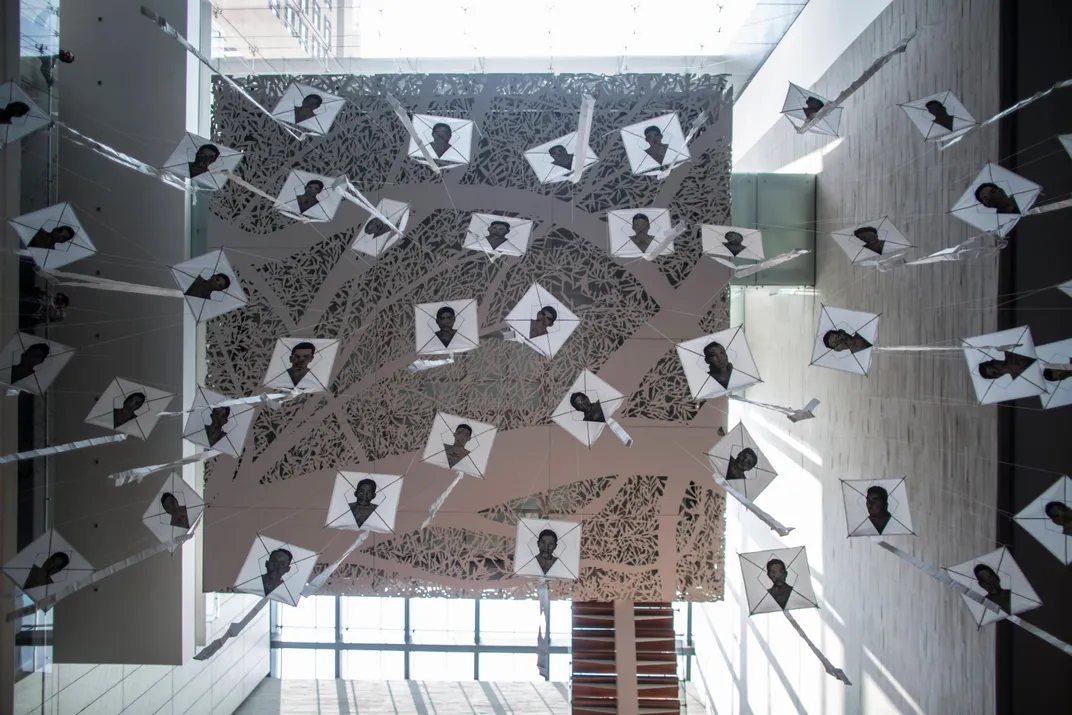
Nosotros came to a big work, of many faces, individual portraits of the 43 students who had been abducted and killed at Ayotzinapa, the faces printed in melancholy tints, like Russian icons, very different from the faces on the "Ayotzinapa Kites."
"Sad," Toledo said. "A tragedy." He steered me out of the exhibit to a modest table, where ii cups of coffee had been placed, along with a pile of my books. "Sit—please. Y'all can sign them? For our library."
I signed the books, and thanked him for meeting me at curt find. I told him he was the merely person in Oaxaca I had wished to meet, and when I said this was not simple adulación, he dismissed information technology with a wave of his hand.
"My English is no adept."
"It's perfect."
"I'm former, I forget," he said. "I'thousand going to finish painting sometime."
"Delight don't say you're quondam," I said in Castilian. "Considering I'grand the aforementioned age." And using the Mexican expression for an older person, "Nosotros are men of judgment."
"Maybe. I similar to think so," he said in English.
"I'm interested that you lot went to Paris when yous were very immature," I said.
"Yes," he said. "But in Paris I was alone, and lonely. I worked, I did painting and prints. Tamayo was kind to me. I felt less solitary with him."
The renowned Mexican painter Rufino Tamayo had gone to Paris in 1949—fled, perhaps, considering he found himself out of sympathy with the passionately political muralists such as Rivera and Orozco, and he was skeptical of revolutionary solutions. Tamayo, wishing to get his own way, took up residence in New York City, and subsequently the war worked in Paris. He encouraged Toledo to paint in his studio, and though Tamayo was 40 years older than Toledo, they had much in common, proud of their Zapotec ethnicity, both resisting classification, making fine art in prints, in painting, in sculpture; and in the end, Tamayo returned to Oaxaca, like Toledo.
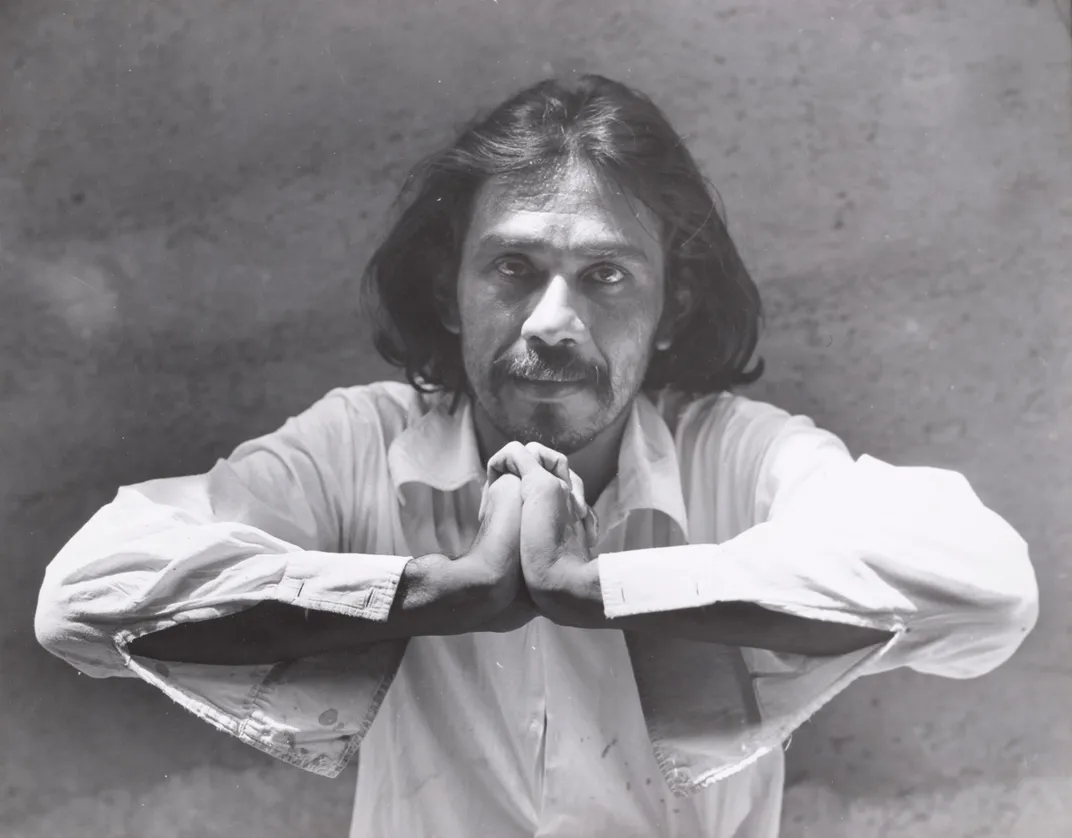
"I came back to be amid my own people and my family," Toledo told me. "I wanted to speak Zapoteco again, in Juchitán."
"And so you lot were happy then?"
"No. I couldn't piece of work there," he said. "It was the noise, too much activity. I liked the place—I was home. I could speak Zapoteco—my grandad and begetter and others spoke it. I don't speak it well—I understand it. But I wanted to pigment, so I left."
"Did you miss Paris?"
He artsy his considerable head. He said, "In Paris I cruel in love with a woman. She was Vietnamese. I had an idea. I planned to become to Vietnam with her—this was 1964, when information technology was very bad there."
"What was your idea in going to Vietnam in wartime?"
"Just to come across it," he said. "I thought I could teach drawing in classes to American soldiers. And I could meet the girl's parents." He shrugged. "But the daughter's parents would non support my awarding for a visa. And so in the end I left Paris. I went to New York City, but I was lone at that place too."
I mentioned my feeling of meeting someone my own age, how we had both lived through the events of the 1960s—Vietnam, demonstrations, political and social upheaval. He had experienced at close manus the massacre of students in 1968 in United mexican states City and was and so outraged by it he removed his paintings from a government-sponsored exhibition presently later on, destroyed some of them and sold others, giving the coin to the families of the murdered students.
"Yous're my age—just you lot're strong," he said. He clapped me on the shoulder. "Driving your car in Mexico!"
"But I'm sure yous drive."
"My wife drives—simply me," he tapped his chest regretfully. "My heart."
"What happened to the Vietnamese woman?"
"Funny thing. She married a Thousand.I. and went to live in California," he said. "Now she's a widow, and old, but I still talk to her. She comes to Oaxaca—I see her hither, we are friends." He became restless, adjusting his posture on the chair, holding the coffee loving cup simply not drinking. He said, "Take y'all seen what is happening in United mexican states?"
"I've traveled a little bit—driving around. I drove from the border, stopping in towns and talking to people. I stayed a while in Mexico Metropolis. I'grand trying to brand sense of United mexican states."
"Good for you, amigo!" But he said he didn't travel, and he gave me his reasons. "Roads are dangerous. Planes are dangerous. I don't like airports. I don't like the colors of the insides of planes. I don't like the smells."
We talked about United mexican states City. He told me of his studies at that place, and the artists he'd met. I asked him what he thought of Frida Kahlo, because as a budding artist he would have known her work when she was at the middle of attention, every bit an creative person, as a public effigy, iconic, adored or disputed over—she died in 1954.
"I started out hating her," he said. "Then I later began to see that she represented something. And outsiders were interested in her. Her life was and so complex and painful. And so she is something," he said. And so as an reconsideration, "Merely in that location are so many others!"
To change the subject, and suggest a place I'd been, I clicked on my phone and showed him a photo I'd taken of a tiny peasant woman in a remote mountain hamlet in the Mixteca Alta.
Toledo peered at the photo and frowned. "She'due south poor," he said. "Nothing will happen to her. No 1 cares almost her, or people like her. No ane cares well-nigh the poor, or nearly their lives. The government doesn't care."
He brooded a chip and sipped his coffee.
"Mexico is in a bad fourth dimension now," he said. "Information technology'southward not merely the U.South. and Trump. Information technology's other things. Drugs and gangs, and the immigration from Central America." He gestured, spreading his thin arms, his delicate fingers. "Oaxaca is in the eye of it all."
This virile and humorous man, total of life, full of ideas and projects, is an optimist in action and in his art, simply a skeptic in thought. He fully acknowledges the human impulse toward self-destruction.
"But you lot're working," I said. "That's the of import thing. Tamayo worked until he was ninety."
"He was stiff. I'm not," he said. "My studio is here, I'm notwithstanding painting. I wait at the paintings I've done and I'm not that satisfied. I've done and so many! I want to move on and do other things."
He got up and led me back into the exhibit, past the metal sculpture and the felt hats, the light box of transparencies of a human body, pull-toys, and laser cuts of insects, including a large black scorpion.
"Right now, I am doing cocky-portraits. I started doing self-portraits kickoff when I had no money. But I had a mirror! I couldn't exercise nudes. They said, 'You're too young.' I fabricated a self-portrait yesterday—not i, many. I brand ten or more at a time."
In 1 show not long ago, titled, "Yo Mismo/I Myself" there were more than 100 self-portraits, all of them striking, some of them astringent, others self-mocking, the greater number depict a man with anxious and disturbed features.
"Did yous work today?"
"I work every day."
"What did you paint today?"
"Recently some people in Mérida asked me to do some pictures of pyramids. I've been doing that, lots of them."
He opened a chest in which booklets were piled. I took them to be children's books, merely he explained that they were stories he had illustrated.
"I'm a publisher, too," he said. "I published these—I want to publish more."
I picked upwards a few and leafed through them, and was impressed past the care with which they had been printed: lovely designs, beautiful typefaces, glowing illustrations—of fabulous animals, jungle foliage, witchlike faces with intimidating noses.
"Maybe yous can write a story for me," he said. "I'll brand a picture. I'll publish it."
"I'll write 1, equally soon as I take an idea."
"Skilful, good," he said, and we shook hands. Then he hugged me, and in a whirl—his bouncing gait, his wild pilus—he was gone.
Sometime subsequently that a Mexican friend of mine, strolling in Oaxaca, saw Toledo hurrying to his library. He said hello and mentioned my visit.
"He's a good gringo," Toledo said. You lot tin can't accept higher praise than that in Mexico. But my friend had more to report. He texted his fiancée in Mexico City: "I just saw Toledo."
"Pide un deseo," she texted dorsum. "Make a wish." Because any encounter with this powerful human, or his work, was lucky, magical, an occasion to celebrate.
*Editor's note, May 29, 2019: An earlier version of this story noted that Toledo's first Paris evidence was in 1936, when, in fact, it was in 1963. The story has been edited to correct that fact.
Source: https://www.smithsonianmag.com/arts-culture/what-makes-francisco-toledo-180972172/

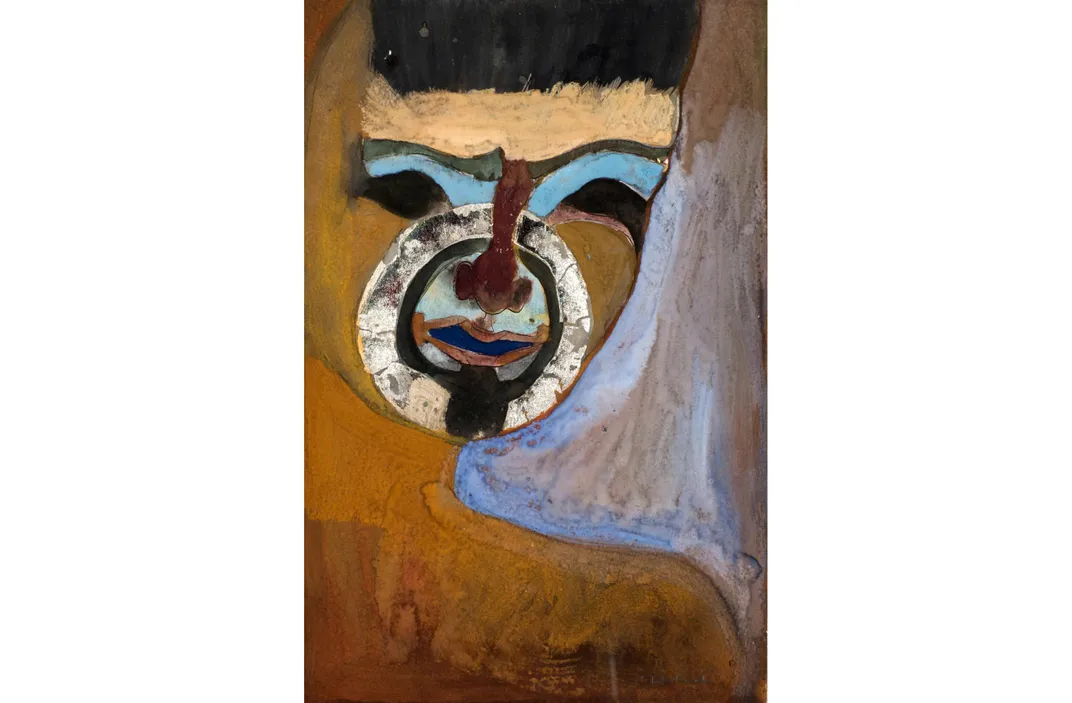
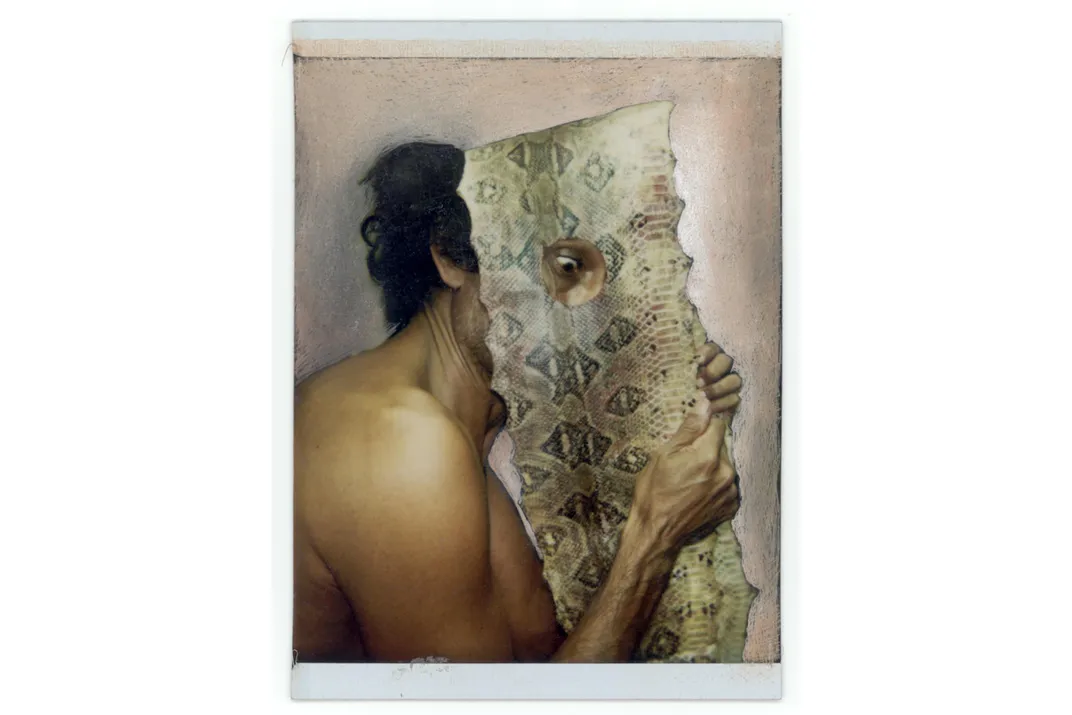
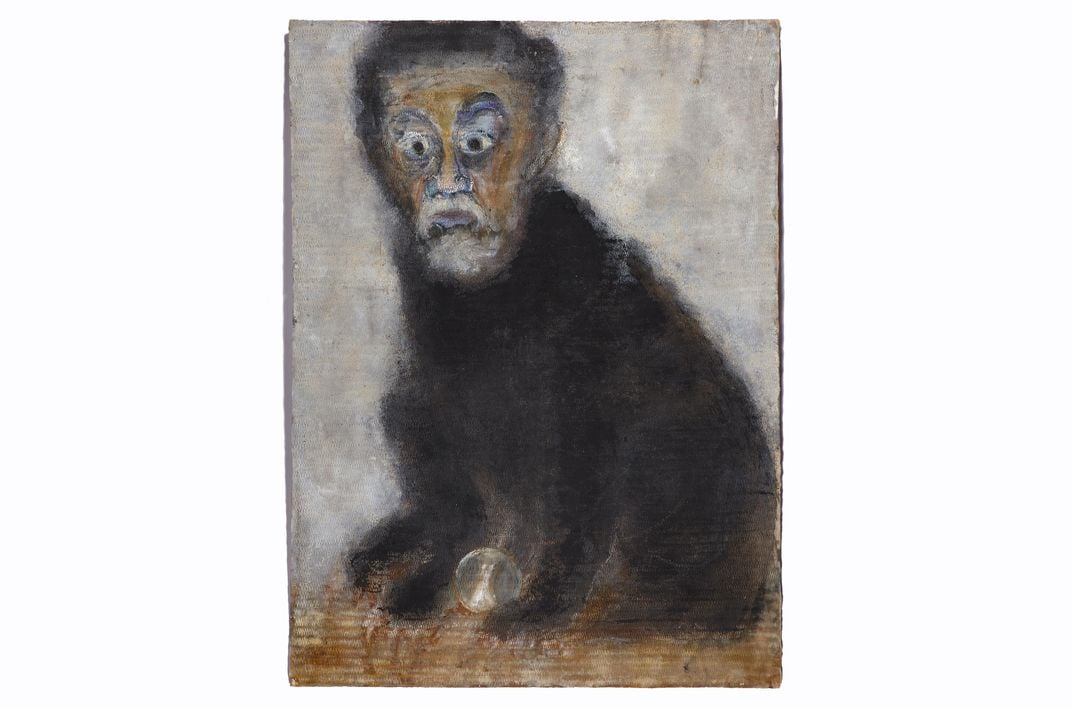
/https://tf-cmsv2-smithsonianmag-media.s3.amazonaws.com/filer/c7/e6/c7e6f254-f1d3-45a6-a97e-dd5d33830b2e/jun2019_g12_franciscotoledo.jpg)
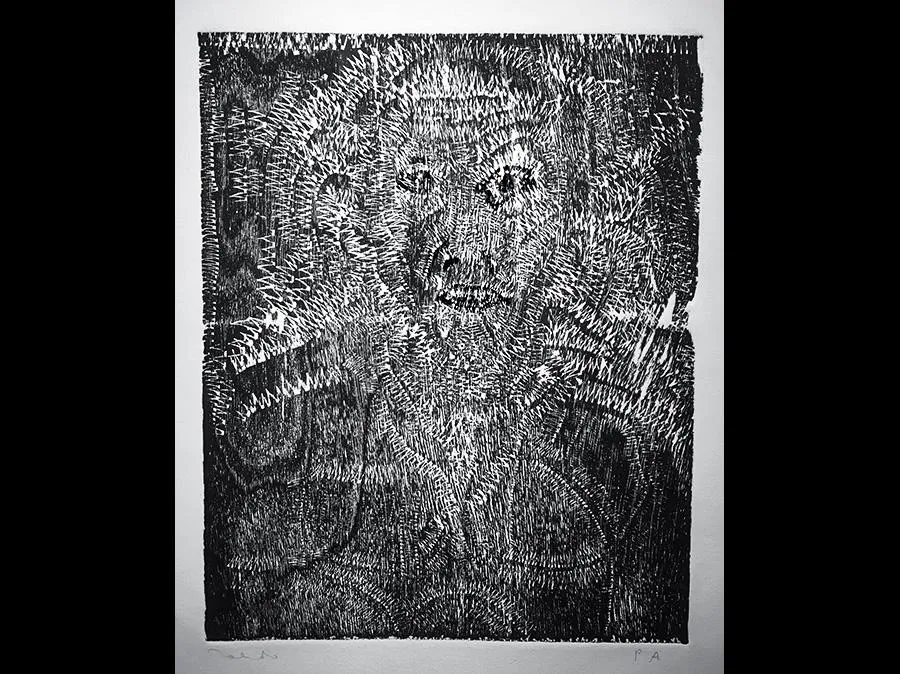
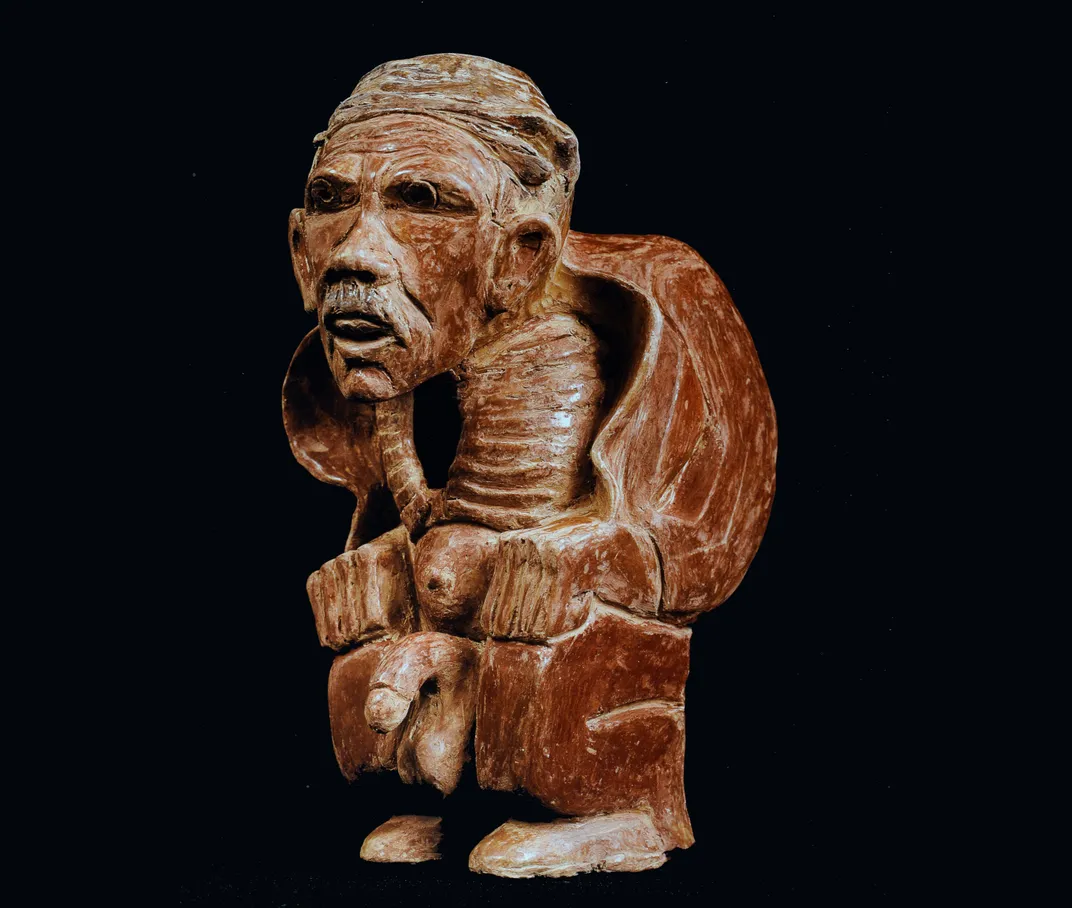
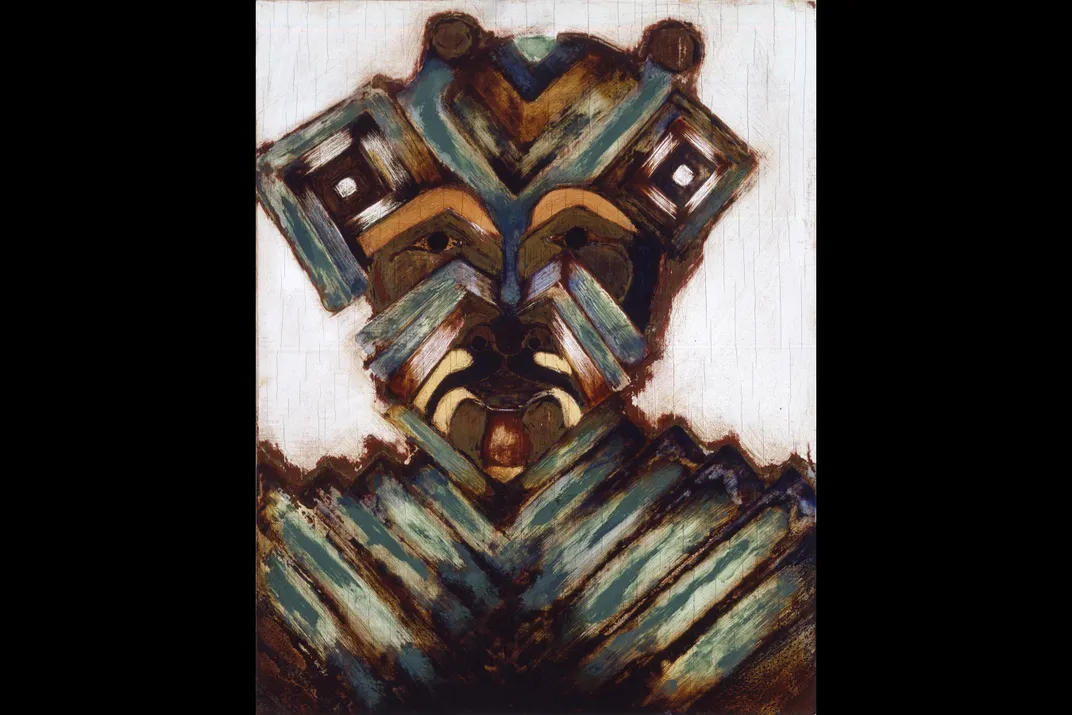
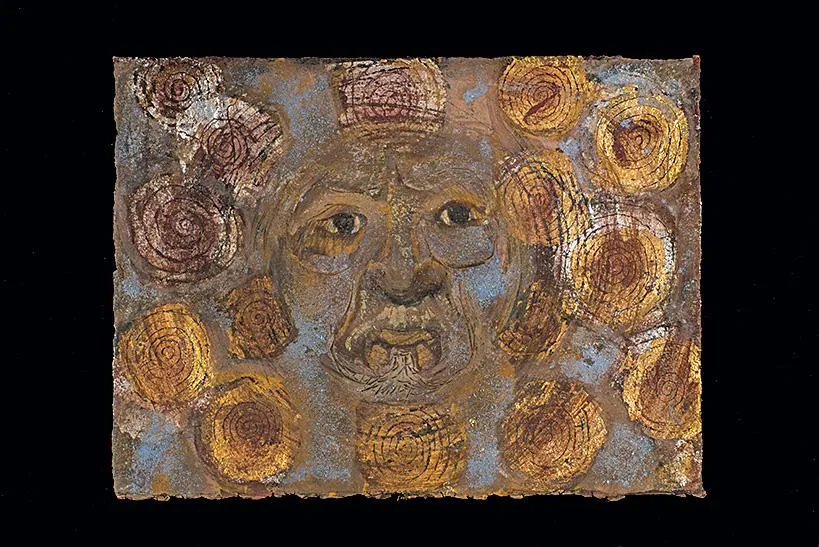
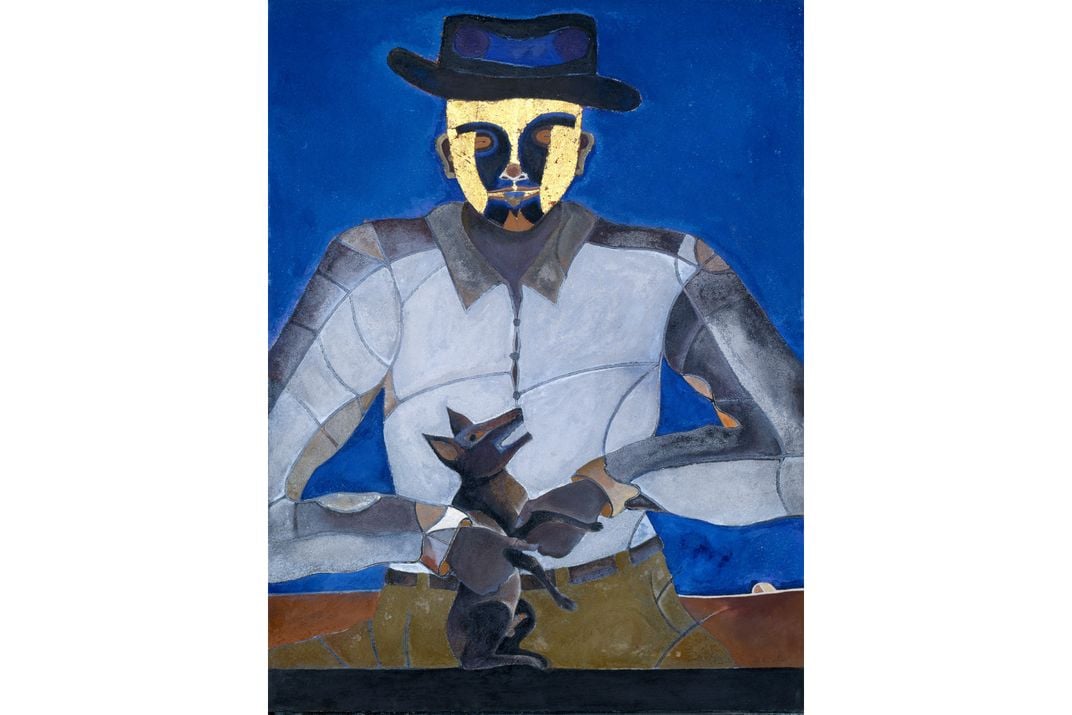
0 Response to "You Can Go Home Again Toledo Magazine"
Post a Comment